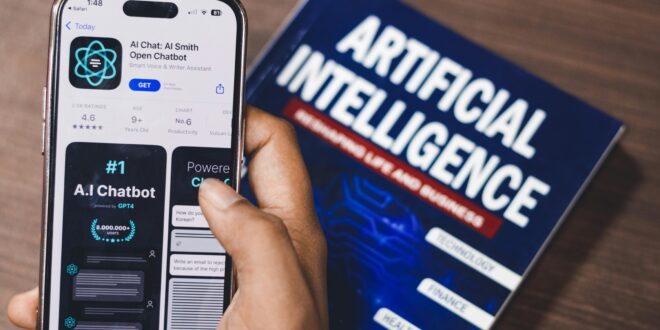Issue 37, Winter/Spring 2024
https://doi.org/10.70090/SN24AIAT
Abstract
In the past decade, artificial intelligence (AI) has rapidly developed and proliferated. This growth is revolutionizing business and commerce, as well as how individuals interact. The industry of media, which encompasses broadcasting, advertising, entertainment, and journalism, has been impacted by this novel and revolutionary force. As a result, this industry is experiencing seismic upheaval due to integration of different AI technologies, which provide new curation and content creation capacities. An AI system might sift through huge volumes of data, which may include trends on social media, user preferences, and historical data, to provide individualized and engaging content. The impact of AI on this industry will be examined in this research. A detailed understanding of the effects of integrating AI in different dimensions of media is examined via the literature review, which will highlight key ideas as well as themes. This research paper will demonstrate how AI technologies have changed this industry by providing the previously unavailable capacity to efficiently analyze data automatically, alter dynamics of workplace, maximize techniques of advertising, and personalize the user’s experience.
Introduction
The lives and experiences of media users are affected by AI daily, and this is often unbeknownst to the users. Algorithms are effective and popular tools used throughout the internet by innumerable online companies. However, this popularity comes at expense of vague accountability, systematic discrimination, and limited transparency. The filtering procedures of algorithms may lead to a more impartial, as well as fairer, processes when compared to procedures governed by people (Dwivedi et al. 2021a). However, the recommendation processes of algorithms are criticized for a tendency in reproducing or intensifying bias, process opacity, distortion of facts, and information asymmetry. Recent research highlights different normative implications, along with problems associated with such algorithms, which include transparency, fairness, and accountability. These should be fundamental attributes of any ostensibly trustworthy algorithmic system that processes sensitive data. These same issues already influence media organizations due to the profound transformations in the last decade, which have been fueled by the growing integration of AI technologies (Airoldi and Rokka 2022). Whether examining audience engagement, content creation, content distribution, as well as many other aspects of media production, AI technologies have revolutionized how media content is consumed, produced, and delivered.
Aims and Objectives
The aim of this research is to examine the impact of AI on marketing strategies and media advertising. Further, this research aims to ascertain how AI might impact the workforce in this sector of media. Objectives of this research include examining AI’s impact on the industry of media while considering content creation, workforce, and marketing. Further, the research will investigate moral concerns and challenges regarding AI’s employment in media. As such, this research will discuss how AI can influence creation, consumption, and distribution of different media. It will address how AI can be used in media, as it pertains to both digital and print media, to better understand the disruptive effect that AI exerts on monetization, production, and distribution.
Literature Review
Applications and Impact of AI Technologies in Content Creation
The impact of AI on content creation has been a transformative force that influences media in a variety of way, which includes creative content, articles, and videos (Taeihagh 2021). AI demonstrates a remarkable potential to streamline content creation by offering different new creative possibilities and enhancing efficiency. Language models powered by AI have made strides toward generating human-like articles. Such models leverage huge datasets along with sophisticated algorithms for understanding context, relevant information, and language structure (Reviglio and Agosti 2020). In the future, AI-generated articles may cover different topics while mimicking a particular author’s writing style. Journalists and content creators may benefit from each AI-generated draft that could serve as an initial foundation for more refinement while providing additional unique insights.
However, different ethical considerations are vital to consider at it pertains to AI auto-generated content. These algorithms must ensure the integrity, as well as accuracy, of output information. AI also made inroads into creating video content. AI-powered tools for video generation may automate different tasks, such as visual effects, video editing, and captioning, which may correspondingly speed up production while saving time and human labor. AI could analyze audio transcripts, generate corresponding video scenes, and animate text content automatically to create efficient visual narratives (Nowotny 2021). However, despite the promise of videos generated by AI, there are challenges as it relates to maintaining artistic expression and storytelling coherence.
Content Distribution based on AI
The role of AI in the distribution of media content has reshaped how content reaches and engages with audiences, which includes virtual assistants, personalized recommendations, and audience targeting. Recommendation systems powered by AI have become integral to the distribution of content on different digital platforms. Such systems analyze huge volume of user data, which includes browsing behavior, content interactions, and search queries. This data is then analyzed by the algorithm to better understand individual interests and preferences. By leveraging this capacity, AI could deliver more personalized content to users, which may enhance user engagement as well as user experience (Dwivedi et al. 2021b). As such, personalization may benefit both content creators and users. On the user side, content that aligns with the user’s interest will likely keep users more engaged as a result of finding content they enjoy. On the creator side, personalized recommendations may lead to increased consumption of content, better retention of users, and more monetization opportunities via targeted advertising.
Content Consumption and AI
Integration of AI has influenced patterns of content consumption significantly by transforming how every user interacts with media platforms and corresponding content (Saurwein and Spencer-Smith 2021). Every AI-driven technology has brought about efficient and personalized delivery of content, increased engagement of users, and improved experiences for users, which leads to a more engaging and dynamic landscape. Every AI-driven technology, like virtual assistants and chatbots, has transformed the user experience. Real-time assistance is provided by chatbots that offer support and respond to user queries, which provides an interactive, as well as seamless, user experience (Babatunde et al. 2024) In addition, AI-powered user interfaces and content creation apps optimize the experience of users on different digital platforms. Using data-driven insights based on AI, media firms can design different user interfaces that are intuitive and specifically tailored to each individual preference, which may ensure a user-friendly and engaging experience (Karnouskos 2020). AI has also facilitated development of interactive content that enhances user engagement. Virtual reality and augmented reality experiences immerse users in interactive storytelling. Such experiences offer captivating and unique ways to consume content and increase user involvement and engagement.
Methodology
This research will employ a systematic literature review (SLR), which provides an orderly and thorough analysis of previous research to identify major topics, research needs, and trends. The strategy that underwrites an SLR includes an exhaustive and comprehensive search to identify scholarly sources, which includes industry reports, academic papers, and research publications. This research is conducted by searching databases, such as Google Scholar, IEEE Explore, and ACM Digital Library. While searching these databases, pertinent phrases regarding AI will be utilized. The research relied on exclusion and inclusion parameters to ensure the selection of appropriate materials. Some examples of criteria of inclusion include relevance to objectives of study, language of articles, and publication date. Only articles that meet the criteria of inclusion will be included in this research. Shortlisted publications will be subjected to a two-phase screening process. Criteria for inclusion, as well as exclusion, will be used to initially evaluate abstracts and titles. In second phase, every article will be assessed to determine if it is appropriate for this research. This process of screening will be thoroughly conducted, and efforts were made to avoid partiality to ensure neutrality. The extraction of data is a methodical removal of appropriate information from selected publications, which include theoretical frameworks, key findings, research methodology, publication years, and author names. The collected data will be organized and synthesized through the thematic analysis, which involves synthesizing recurrent themes and patterns. To confirm validity and reliability of the research a quality assessment was performed. The validity of findings, techniques of data analysis, sample size, and study design are criteria that are evaluated during this process. This assessment will determine the caliber of supporting data and how it impacts the conclusions of this research. Collated data will be presented in narrative format to summarize key concepts and themes from selected literature. Findings will be organized by selected study areas, research objectives, and contributions, which aim to streamline the research findings. The exclusion of non-English publications, publication bias, and reliance upon previously published research are limitations of employing SLR.
Framework
This investigation of AI technologies impacting media will be filtered through frameworks to guide content interpretation and analysis. The social construction of technologies framework posits that technology is socially generated, which is a process that is influenced by different social, institutional, and cultural factors. This paradigm is effective at examining organizational practices, sociocultural settings, and power dynamics of the media industry as it relates to the impact of AI (Manoharan 2024). This highlights the relationship between society and technology, which render it possible to effectively examine difficulties of AI implementation. The second framework is technological determinism, which posits that processes, behavior, and structures of society are shaped by technology. Such a perspective helps comprehend how integration of AI in media has altered the processes of content creation, advertising, distribution, and worker dynamics (Gupta et al 2024). This framework recognizes that AI is a passive instrument, while both affecting and reconfiguring the landscape of media. The integration of ethical frameworks is vital in assessing moral dilemmas that arise due to AI integration in media. By applying different ethical theories, such as virtue ethics, deontology, and utilitarianism, individuals can better assess ethical implications of AI, which includes worker dynamics, algorithmic bias, and privacy issues (Rathore 2023). The media ecology framework emphasizes an interconnection of technologies within the spheres of media, environment, and human communication. This framework allows for the effective analysis of interactions between ecosystems of media and AI technologies, which include altered patterns of content consumption, dynamics of media organization, and communication patterns (Sheikh 2020). This posits what effects the integration of AI will have on the environment, as well as society.
As such, this research examines different impacts of AI on media through selected theoretical frameworks. This undertaking enables a better understanding of ethical concerns, promises, and challenges generated by AI through an overall assessment of ecological, ethical, social, and technological components (Grover et al. 2022). These frameworks provide a foundation to decipher research findings and examine pertinent inferences. Another vital aspect of these frameworks pertains to ethical frameworks, which exist for AI’s adoption in media.
Research
AI has radically changed content creation and curation in media. Automated technologies that use algorithms of AI can produce huge volumes of information efficiently and quickly (Truong and Papagiannidis 2022). This capability has different implications for creative writing, news reporting, and creating videos. Editing techniques assisted by AI offers cutting-edge opportunities to enhance the quality of content by providing efficient video editing, audio augmentation, and automatic cropping of image. Systems that utilize AI to target content at customers may increase user engagement, as well as satisfaction (Shin et al. 2022). Though concerns exist regarding novelty, as well as the accuracy of content generated by AI, there are also issues involving human’s maintaining creative control of content. AI-powered platforms for content distribution have changed how media is consumed. Such platforms optimize strategies of content distribution to ensure users engage with the content (Puntoni 2021).
Every AI system combs through huge amounts of data that include behavioral tendencies, user preferences, and demographics for categorizing audiences along with identifying trends within content consumption. Due to efficient data-driven strategies, every platform to disseminate information could target specific user categories while tailoring content recommendations. Also, while optimizing delivery of content, algorithms of AI consider user location, device compatibility, and network conditions. It ensures effective delivery of media along with minimizing issues of latency and buffering (Obaigbena et al. 2024). AI is vital in creating effective individualized user experience by means of recommendation engines. AI algorithms are used by such engines for analyzing contextual data, patterns of content consumption, and user behaviors for producing personalized suggestions. In addition, these engines use approaches of machine learning for understanding user preferences along with providing content recommendations that are pertinent to specific user interests. Such engines learn continuously from user feedback and interactions to continually augment relevance and accuracy of recommendations.
AI has enhanced audience engagement of media. AI-powered virtual assistants and chatbots allow audiences and media firms to communicate efficiently. Content that is browsed by users on AI-powered platforms utilize algorithms to rapidly respond to user-input with personalized recommendations (Bankins et al. 2024). Using technology of sentiment analysis and social listening, media firms can track audience reactions and sentiment toward specific content. Media firms may discover more insight regrading trends, interests, and opinions of audience members by auto-analyzing social media data and user-generated materials. In addition, media firms can more efficiently target content and engage the audience with the aid of data-driven strategies, which provide more relevant and specialized content. Integration of AI in media consumption and distribution has also revolutionized delivery of content, which correspondingly increases engagement of audience through a more personalized user experience (Nassar 2022).
Findings
AI has changed how media content is consumed and distributed. AI-powered platforms for content distribution can optimize media delivery by personalizing the content delivered to each consumer, which is based on data extraction predicated on a specific user’s choice, context, and behavior. AI powers a platform’s recommendation engine to customize user experience and increase user retention. Due to AI content personalization, different media firms have the capability to provide targeted and dynamic materials to each specific user. However, there are some concerns with respect to echo chambers and filter bubbles. This may arise when AI-driven recommendation systems begin to reinforce underlying biases and correspondingly limit exposure to other points of view (Haleem et al. 2022). Moreover, there are privacy issues because of collecting so much user data.
AI also significantly impacts marketing and advertising strategies by enabling audience segmentation that underwrites customized advertising. AI categorizes users into groups based upon characteristics that are extracted from volumes of data, which may include activities on social media, browser history, demographics, and user preferences (Wach et al. 2023). As AI is integrated into media, there have been significant changes as it relates to skill needs and job roles. As specific procedures and tasks are automated by AI technology, some employment categories might be forced to adapt and evolve. With the elimination of requirements for manual creation of content, AI-powered content generation frees content creators to focus on strategies and ideation. Advances in AI have made this feasible by automatically analyzing huge amounts of data that aid media firms by providing insight, improving marketing strategies, and refining content recommendations (Sonko et al. 2024).
Automating processes and editing abilities are underwritten by different AI technologies, which has revolutionized content curation and creation. Moreover, AI has made it easier for media companies to customize and personalize content distribution and correspondingly how users’ access and consume media. In addition, advertising and marketing strategies have been improved via automated targeting and advertising methods, despite ongoing concerns regarding algorithmic bias and privacy (Yun et al. 2020) This clearly illustrates a vital need to address these moral dilemmas. As such, the focus of future research needs to bridge every knowledge gap and explore new territory. Moreover, media promotes innovation and proactively solves issues while enhancing user experience by embracing the potential of AI. Through such undertakings, individuals may contribute to a responsible and ethical definition for the future of AI integration in media.
Conclusion
This research explored integration of AI in media by focusing on its impact on content consumption, creation, and distribution. Formerly, creation of content in media was labor-intensive and time consuming as it relied heavily upon manual effort and human creativity. However, AI’s emergence has disrupted this formerly analog paradigm. Currently, AI has the capacity to generate news reports, written articles, and creative narratives that is transforming the landscape of content creation. Moreover, recommendation systems based on AI have impacted distribution of content. Through the automated analysis of huge volumes of user data, AI personalizes and targets content suggestions, which presents users with engaging and relevant content tailored to their personal preferences. Such enhanced personalization has also revolutionized how every user consumes media, which can lead to increased user retention and satisfaction.
As a result of these tremendous technological changes, media literacy is vital as it pertains to AI generated content. This knowledge may further empower users to identify biases, navigate personalized recommendations, and critically evaluate data. AI’s prospects in media points toward continued innovation in a dynamic landscape. AI technologies will likely continue to evolve, enhance storytelling, improve curation of content, and provide personalized content experience. Moreover, human-AI collaborations may unleash tremendous creative potential. However, it is important to establish ethical governance to ensure a responsible AI that maintains public trust. Integration of AI in media has demonstrated profound impact upon content, consumption, creation, and distribution. While this brings several benefits, the promotion of media literacy and addressing ethical concerns are vital for sustainable and responsible integration of AI. AI’s future holds huge promises, presenting different opportunities for innovation, growth, as well as meaningful engagement with the audience.
 Arab Media & Society The Arab Media Hub
Arab Media & Society The Arab Media Hub





